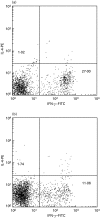Proinflammatory cytokines (IL-17, IL-6, IL-18 and IL-12) and Th cytokines (IFN-gamma, IL-4, IL-10 and IL-13) in patients with allergic asthma
- PMID: 11529906
- PMCID: PMC1906135
- DOI: 10.1046/j.1365-2249.2001.01602.x
Proinflammatory cytokines (IL-17, IL-6, IL-18 and IL-12) and Th cytokines (IFN-gamma, IL-4, IL-10 and IL-13) in patients with allergic asthma
Abstract
Allergen-reactive T helper type-2 (Th2) cells and proinflammatory cytokines have been suggested to play an important role in the induction and maintenance of the inflammatory cascade in allergic asthma. We compared the plasma concentrations of novel proinflammatory cytokines IL-17 and IL-18, other proinflammatory cytokines IL-6 and IL-12, Th2 cytokines IL-10 and IL-13, and intracellular interferon-gamma (IFN-gamma) and IL-4 in Th cells of 41 allergic asthmatics and 30 sex- and age-matched health control subjects. Plasma cytokines were measured by enzyme-linked immunosorbent assay. Intracellular cytokines were quantified by flow cytometry. Plasma IL-18, IL-12, IL-10, IL-13 concentrations were significantly higher in allergic asthmatic patients than normal control subjects (IL-18: median 228.35 versus 138.72 pg/ml, P < 0.001; IL-12: 0.00 versus 0.00 pg/ml, P = 0.001; IL-10: 2.51 versus 0.05 pg/ml, P < 0.034; IL-13: 119.38 versus 17.89 pg/ml, P < 0.001). Allergic asthmatic patients showed higher plasma IL-17 and IL-6 concentrations than normal controls (22.40 versus 11.86 pg/ml and 3.42 versus 0.61 pg/ml, respectively), although the differences were not statistically significant (P = 0.077 and 0.053, respectively). The percentage of IFN-gamma-producing Th cells was significantly higher in normal control subjects than asthmatic patients (23.46 versus 5.72%, P < 0.001) but the percentage of IL-4 producing Th cells did not differ (0.72 versus 0.79%, P > 0.05). Consequently, the Th1/Th2 cell ratio was significantly higher in normal subjects than asthmatic patients (29.6 versus 8.38%, P < 0.001). We propose that allergic asthma is characterized by an elevation of both proinflammatory and Th2 cytokines. The significantly lower ratio of Th1/Th2 cells confirms a predominance of Th2 cells response in allergic asthma.
Figures



References
-
- Yssel H, Groux H. Characterization of T cell subpopulations involved in the pathogenesis of asthma and allergic diseases. Int Arch Allergy Immunol. 2000;121:10–8. - PubMed
-
- Marone G. Asthma: recent advances. Immunol Today. 1998;19:5–9. - PubMed
-
- Kaminuma O, Mori A, Ogawa K, et al. Cloned Th cells confer eosinophilic inflammation and bronchial hyperresponsiveness. Int Arch Allergy Immunol. 1999;118:136–9. - PubMed
-
- KleinJanuary A, Dijkstra MD, Boks SS, Severijnen LA, Mulder PG, Fokkens WJ. Increase in IL-18, IL-10, IL-13, and RANTES mRNA levels (in situ hybridization) in the nasal mucosa after nasal allergen provocation. J Allergy Clin Immunol. 1999;103:441–50. - PubMed
-
- De Waal Malefyt R, Haanen J, Spits H, Roncarolo MG. Interleukin-10 and viral IL-10 strongly reduce antigen-specific human T cell proliferation by diminishing the antigen presenting capacity of monocytes via down-regulation of class II major histocompatibility complex expression. J Exp Med. 1991;174:915–24. - PMC - PubMed
Publication types
MeSH terms
Substances
LinkOut - more resources
Full Text Sources
Other Literature Sources
Medical
Miscellaneous

